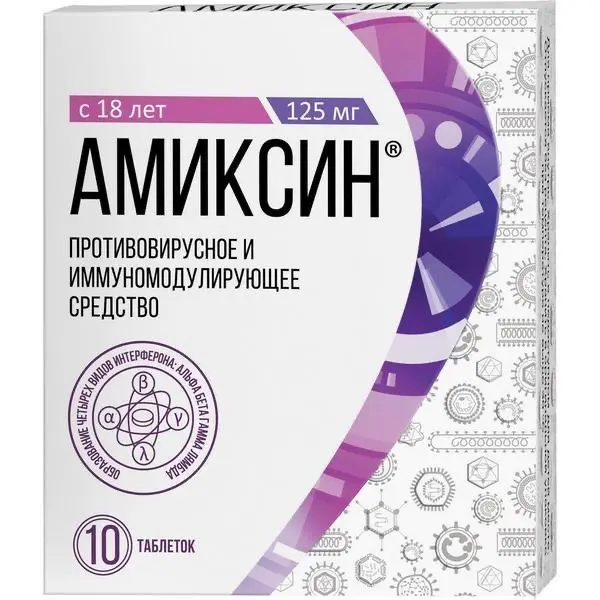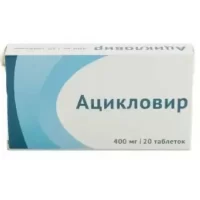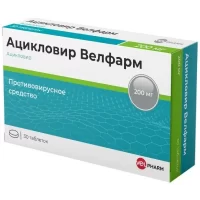Description
Valacyclovir Akos Pharmacodynamics
Mechanism of action
Valacyclovir is an antiviral agent and is an L-valine ester of acyclovir. Acyclovir is an analog of the purine nucleoside (guanine).
In humans, valacyclovir is rapidly and almost completely converted into acyclovir and valine, presumably by the enzyme valacyclovirhydrolase.
Acyclovir is a specific herpes virus inhibitor with in vitro activity against herpes simplex virus (HPV) types 1 and 2; Varicella zoster virus (VZV); cytomegalovirus (CMV), Epstein-Barr virus (EBV) and human herpes virus type 6. Acyclovir inhibits the synthesis of viral DNA immediately after phosphorylation and transformation into the active form – acyclovirtriphosphate.
The first stage of phosphorylation requires the activity of virus-specific enzymes. For HPV, VZV, and VEB, this enzyme is viral thymidine kinase, which is present only in virus-affected cells. Part of the phosphorylation selectivity is maintained in cytomegalovirus indirectly through the product of the phosphotransferase gene UL97. This need for activation of acyclovir by a specific viral enzyme largely explains its selectivity.
The process of acyclovir phosphorylation (conversion from mono- to triphosphate) is completed by cellular kinases. Acyclovir triphosphate competitively inhibits viral DNA polymerase and, being a nucleoside analog, is incorporated into viral DNA, which leads to obligate chain breaking, termination of DNA synthesis and, consequently, to blocking of virus replication.
Resistance to acyclovir is usually due to thymidine kinase deficiency, which leads to excessive spread of the virus in the host. In rare cases, decreased sensitivity to acyclovir is due to the emergence of virus strains with disrupted viral thymidine kinase or DNA polymerase structure. The virulence of these strains is similar to that of the wild strain.
An extensive study of HPV and EHV strains sampled from patients treated with acyclovir or used as prophylaxis found that viruses with hypersensitivity to valacyclovir are extremely rare but may be found in rare cases in patients with severe immune disorders, such as bone marrow or organ transplant recipients, patients receiving chemotherapy for malignancies, and HIV-infected individuals.
Valacyclovir helps relieve pain: it reduces its duration and reduces the percentage of patients with pain caused by herpes zoster, including acute post-herpetic neuralgia.
Indications
Adults and adolescents 12 to 18 years of age
– Treatment of skin and mucous membrane infections caused by HPV, including newly diagnosed and recurrent genital herpes (Herpes genitalis) and labial herpes (Herpes labialis).
– Prevention (suppression) of recurrent infections of the skin and mucous membranes, caused by HPV, including genital herpes, including in immunodeficient adults.
– Prevention of infections caused by cytomegalovirus (CMV) and diseases after parenchymal organ transplantation.
Adults
– Treatment of herpes zoster and ophthalmic herpes zoster.
Contraindications
– Hypersensitivity to valacyclovir, acyclovir or any other component of the drug.
– Childhood under 12 years of age.
– Childhood under 18 years of age for treatment of herpes zoster and ophthalmic herpes zoster.
Caution
Concomitant use with nephrotoxic drugs, renal failure, pregnancy, lactation, clinically expressed forms of HIV infection.
Usage in pregnancy and during breast-feeding.
Fertility
In animal studies, valacyclovir had no effect on fertility. However, the use of high doses of acyclovir when administered parenterally has caused testicular effects in rats and dogs.
Studies on the effect of valacyclovir on fertility in humans have not been conducted. However, no changes in sperm count, motility, or morphology were reported in 20 patients after 6 months of daily valacyclovir administration at doses ranging from 400 mg to 1,000 mg.
Pregnancy
There are limited data on the use of valacyclovir in pregnancy. The drug should be used in pregnancy only if the potential benefit to the mother outweighs the potential risk to the fetus.
Pregnancy outcomes in women taking valacyclovir or other drugs containing acyclovir (acyclovir is the active metabolite of valacyclovir) have been documented in pregnancy registries, 111 and 1246 observations, respectively (of which 29 and 756 took the drugs in the first trimester of pregnancy), representing pregnancy outcomes reported prospectively. Analysis of the data presented in the registry of pregnant women exposed to acyclovir showed no increase in birth defects in their children compared to the general population, and no specificity or pattern indicating a common cause was found for any of the malformations. Because the pregnancy registry included a small number of women who took valacyclovir during pregnancy, reliable and definitive conclusions about the safety of valacyclovir in pregnancy cannot be drawn.
Breastfeeding period
Acyclovir, the main metabolite of valacyclovir, passes into breast milk. After oral administration of valacyclovir at a dose of 500 mg, the Cmax in breast milk was 0.5-2.3 times (1.4 times on average) higher than the corresponding concentrations of acyclovir in maternal blood plasma. The ratio of AUC values of acyclovir in breast milk to AUC in maternal blood serum ranged from 1.4 to 2.6 (mean 2.2). The mean concentration of acyclovir in breast milk was 2.24 μg/mL (9.95 μmol/L). When the mother takes valacyclovir at a dose of 500 mg twice daily, breastfed infants are exposed to the same acyclovir as when it is taken orally at a dose of about 0.61 mg/kg/day. The half-life of acyclovir from breast milk is the same as that of blood plasma.
Valacyclovir in unchanged form has not been detected in maternal plasma, breast milk, or urine.
Valacyclovir should be administered with caution to women during breastfeeding.
However, intravenous acyclovir is used to treat HPV in infants at a dose of 30 mg/kg/day.
Dosage and administration
- Valacyclovir-ACOS is taken regardless of meals, the tablets should be washed down with water.
- Treatment of skin and mucous membrane infections caused by HPV, including newly diagnosed and recurrent genital herpes (Herpes genitalis) and herpes labialis (Herpes labialis)
- Immunocompetent adults and adolescents 12 to 18 years of age
- The recommended dose is 500 mg twice daily.
- In cases of relapses, treatment should continue for 3 or 5 days. In the case of primary herpes, which may be more severe, treatment should be started as early as possible and its duration should be increased from 5 to 10 days. In case of recurrent HPV, it is most correct to prescribe Valacyclovir-ACOS in the prodromal period or immediately after the appearance of the first symptoms of the disease. Valacyclovir use can prevent lesions from developing if used at the first signs and symptoms of relapse caused by HPV.
- As an alternative treatment for labial herpes, Valacyclovir-ACOS is effective at a dose of 2,000 mg twice daily for 1 day. The second dose should be taken approximately 12 hours (but not earlier than 6 hours) after the first dose. When using this dosing regimen, the duration of treatment should not exceed 1 day, since exceeding this duration of treatment leads to no additional clinical benefit.
- Therapy should be initiated when the earliest symptoms of labial herpes (i.e., tingling, itching, burning) appear.
- Prevention (suppression) of recurrent infections of the skin and mucous membranes caused by HPV, including genital herpes, including in immunocompromised adults
- Immunocompetent adults and adolescents 12 to 18 years of age
- In immunocompetent patients, the recommended dose is 500 mg once daily.
- The efficacy of therapy should be evaluated after 6-12 months of treatment.
- Adults with immunodeficiency
- In adult patients with immunodeficiency, the recommended dose is 500 mg 2 times a day.
- In 6-12 months of treatment it is necessary to evaluate the therapy efficacy.
- Prevention of infections caused by CMV and disease after parenchymal organ transplantation
- Adults and adolescents between 12 and 18 years of age.
- The recommended dose is 2000 mg 4 times daily, administered as soon as possible after transplantation. The dose should be reduced depending on creatinine clearance.
- The duration of treatment is usually 90 days, but in high-risk patients the course of treatment may be extended.
- Treatment of herpes zoster and ophthalmic herpes zoster
- Adults
- The recommended dose is 1000 mg 3 times a day for 7 days.
- Special patient groups
- Children
- The efficacy of Valacyclovir-ACOS treatment in children has not been studied.
- Patients of elderly age.
- Possible impairment of renal function in elderly patients should be taken into account, the dosage of Valacyclovir-ACOS should be adjusted accordingly.
- Adequate water-electrolyte balance should be maintained.
- Patients with impaired renal function
- The dose of Valacyclovir-ACOS should be reduced in patients with severe renal dysfunction (see dosing regimen in Table 2). In such patients an adequate water-electrolyte balance should be maintained.
- Table 2. Dose adjustment of Valacyclovir-ACOS for use in adults and adolescents aged 12 to 18 years with impaired renal function
- Indication Creatinine clearance, ml/min Dose of Valacyclovir-ACOS
- Herpes zoster and ophthalmic herpes zoster in immunocompetent adults (treatment) at least 50
30 to 49
10 to 29
less than 10 1,000 mg 3 times daily
1000 mg two times a day
1000 mg once daily
500 mg once daily
HPV (treatment) - Immunocompetent adults and adolescents 12 to 18 years of age
not less than 30
less than 30 500 mg twice a day
500 mg once daily - Labial herpes in immunocompetent adults and adolescents 12 to 18 years of age (treatment) at least 50
30 to 49
10 to 29
less than 10 2,000 mg 2 times daily
1000 mg two times a day
500 mg two times a day
500 mg 1 time per day
HPV (prophylaxis (suppression)) - Immunocompetent adults and adolescents between 12 and 18 years of age at least 30
less than 30 500 mg 1 time per day
500 mg 1 time per day - Adults with immunodeficiency at least 30
less than 30 500 mg twice a day
500 mg 1 time per day - Prevention of infections caused by CMV in adults and adolescents 12 to 18 years of age at least 75
50 to 75
25 to 50
10 to 25 - Less than 10 or in patients on hemodialysis 2000 mg 4 times daily
1500 mg four times daily
1500 mg 3 times daily
1500 mg 2 times daily
1500 mg 1 time daily





